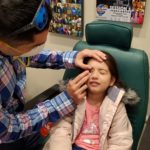
Dr. Mena with a young patient. Dr. Mena says myopia management provides an essential treatment while also offering a huge practice growth opportunity.
By Vittorio Mena, OD, MS
June 29, 2022
As we learn to live with COVID-19 as part of our ongoing reality, and life is mostly back to “normal,” there are new practice opportunities to be had. Here are a few I’m pursuing.
Increased Screen Time Means More Need for Myopia Management
“Screen time outside of virtual school among teenagers doubled from pre-pandemic estimates of 3.8 hours per day to 7.7 hours,” according to a study in JAMA Ophthalmology. And that’s in addition to the screen time children were already doing for school. That is one of the reasons I am strengthening my focus on myopia management, which has been linked to increased screen time, as well as prolonged usage of up-close reading or near activities for hours on end.
Projections suggest that almost 50 percent of the world will be myopic by 2050, according to the National Eye Institute, so we as optometrists need to be on the front line of this progressive disease. We have a few options currently on the market to manage myopia, including soft multifocal center distance contact lenses, Ortho-K and compounded atropine eye drops (0.01%, .025% or .05%). In the near future, there will be glasses specifically designed for myopia management that will be available in the U.S.
Many practitioners feel that if they do not have axial length measuring equipment they cannot provide myopia management services. However, even if you do not have this device you are still able to provide myopia management. Remember, education first is key so parents at least understand this is something to be concerned about and that options for treatment exist. As practitioners, we should educate every parent about the ways to slow myopia progression.
I recommend developing a 2-3 minute educational pitch that explains to parents the risks myopia poses to eye health and the options that now exist for controlling its progression.
Basic costs for myopia management equipment are as follows: Auto refractor/keratometer: $3,000 (preowned) -$20,000, corneal topographer $4,000 (preowned)-$20,000, optical biometer: $5,000 (preowned)-$40,000 (New), Ortho-bvgfy6K: Fitting Set $500.
Each myopia management patient can bring an average of $3,000 annually into a practice. That means that a robust myopia management niche could easily become a practice sub-specialty that generates $100,000, or more, annually.
Enhanced Focus on Wellness Means Greater Opportunity to Successfully Educate About Prevention
With our attention focused on staying healthy over the last couple of years, many patients may be more attuned to messages about preventative health.
In my practice, we are focusing on increasing prescriptions and sales for MacuHealth. We need to be proactive instead of reactive. Macular degeneration is the number one cause of vision loss, and is more common than glaucoma. Sadly, we usually wait for the disease to occur before we educate our patients about the preventative benefits of nutraceuticals.
If we start patients early on nutraceuticals, not only will it possibly help protect their macula, but it may also help their brain function. There are many studies showing that nutraceuticals have the effect of slowing cognitive decline. These beneficial nutrients include not only lutein, zeaxanthin, meso-zeaxanthin, but also a high-quality fish oil (Omega-3) incorporated into patients’ diets, in addition to increased consumption of fruits and vegetables when in season and minimizing fried and sugary foods.
Other Articles to Explore
I am already heavily in the nutraceutical space for sports vision patients via a supplement called VIZION EDGE, which has been shown to be beneficial to patients. Sales of this eye vitamin generate an additional $14,000 annually for my practice. I am striving for sales of MacuHealth to generate a similar level of yearly revenues.
Masks Moved Many to Try Contact Lenses. Now Make Sure They Are In the Best.
During the pandemic, more contact lens sales occurred due to glasses getting fogged up with masks on. Masks also can worsen dry eye. For those reasons, I am not only prescribing and selling more contact lenses, but more daily disposables. The added hygiene of having a lens that gets thrown away after each use is also an easy sell as patients emerge from a time when they were hyper-focused on germs.
I continue to prescribe daily disposable lenses as the first option for every contact lens wearer who fits within the daily parameters. The front staff recommends daily contact lenses to our patients when they walk in, as will our technician, then the doctor, then finally at checkout with the optician, the patient will hear yet again about the benefits of daily disposables. After hearing that same message 3-4 times, and after trying daily disposables for themselves, most will decide to make a purchase.
The patient wins because they are more comfortable and hygienic in their lenses and the practice wins due to the greater profitability of selling daily disposable contact lenses. When you sell an annual supply of a daily disposable lens (depending on the type) over a two-week or monthly lens, the practice makes on average an extra $50-$150 per patient. An extra $150 per patient means that every 10 patients generate an additional $1,500–and I average at least 40 patients per month switching from a monthly or two-week lens to a daily disposable. $1500 x 4 = $6,000/month and $6000 x 12 = $72,000/year.
The practice also wins because the patient in a best-in-class daily disposable will probably be more comfortable than a patient in a second- or third-tier lens. And happy patients are more likely to tell friends, co-workers and family members about your practice.
 Vittorio Mena OD, MS, is the sports vision director with Optical Academy. To contact him:menavitt@gmail.com
Vittorio Mena OD, MS, is the sports vision director with Optical Academy. To contact him:menavitt@gmail.com

























